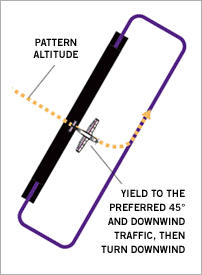| This ePilot Flight Training Edition is sponsored by

Advertisers
                   
Do not reply to this e-mail. Got news? Contact ePilot. Having difficulty using this service? Visit the ePilot Frequently Asked Questions now at AOPA Online or write to [email protected].
Aircraft Owners and Pilots Association
421 Aviation Way
Frederick, MD 21701
Tel: 800/USA-AOPA or
301/695-2000
Copyright © 2007 AOPA. | | Training Tips | | THE MIDFIELD CROSSWIND
 The Nov. 16, 2007, Training Tips took up some of the hot topics pilots debate about how to fly traffic patterns at nontowered airports. For many, the most daunting task is how to enter a traffic pattern when arriving from the side of the airport opposite to that on which the pattern is flown. The Nov. 16, 2007, Training Tips took up some of the hot topics pilots debate about how to fly traffic patterns at nontowered airports. For many, the most daunting task is how to enter a traffic pattern when arriving from the side of the airport opposite to that on which the pattern is flown. The most common method is to fly beyond the airport, descend to traffic pattern altitude (TPA) when safely clear—approximately two miles out—then make a 45-degree entry to the downwind leg. When inbound traffic flows or other considerations merit, there is another way. "An alternate method is to enter on a midfield crosswind at pattern altitude, then turn downwind. Give way to aircraft on the preferred 45-degree entry and to aircraft already established on downwind," explains the AOPA Air Safety Foundation's Safety Advisor, Operations at Nontowered Airports . See Figure 10 in the Safety Advisor for an illustration of the midfield crosswind entry. Any time you are in a nontowered airport traffic pattern, good communications, using the aircraft's landing light, and being established at the correct speed when you join the flow all enhance safety. Improvised procedures and nonstandard arrivals spell trouble, as the August 2003 AOPA Flight Training "Accident Analysis" column makes clear. Stay alert and situationally aware. This is no time to get sloppy about altitude—especially on the low side. Consider that an aircraft taking off from that same runway and climbing 1,000 feet per minute could reach TPA before clearing the departure end—especially if its groundspeed [see the Dec. 12, 2003, Training Tips article "Grasping Groundspeed"] is low because of a strong headwind. Know the wind and never take vertical separation for granted. The more you study traffic pattern procedures at nontowered airports, the more you realize that with freedom to make choices comes responsibility to choose well and fly your best.
| | Your Partner in Training | | Don't wait until the last minute—or the day before you're ready to solo—to get your student pilot medical certificate. View the Frequently Asked Medical Certification Questions and use AOPA's TurboMedical, an online form that takes you step by step through the medical application and flags any problem areas. If you still have questions, call our aviation medical certification specialists at 800/USA-AOPA. Do you have a question? Call the experienced pilots in AOPA's Pilot Information Center at 800/USA-AOPA. They're available to take your calls weekdays 8:30 a.m. to 6 p.m. Eastern. As an AOPA Flight Training Member, you have access to all of the features within AOPA Online and AOPA Flight Training Online. Login information is available online.
| | Flight Training News | | DUBAI FLIGHT ACADEMY ORDERS CIRRUS SR22s, ECLIPSE JETS
A new ab initio pilot training program in the United Arab Emirates is gearing up for business in a big way. Dubai Aerospace Enterprise Flight Academy (DAEFA) has acquired two Cirrus SR22s as part of a long-term agreement with Cirrus Design Corporation to provide aircraft for flight training. In the same week, Eclipse Aviation announced that it has sold 12 Eclipse 500 jets to DAEFA. The training academy is set to open in March 2008 and will offer a 12-month course in which students begin training in the SR22, move to the Eclipse, and finish with a type rating in a multi-crew jet transportation aircraft. LEWIS UNIVERSITY TO PROVIDE ATC TRAINING
Lewis University in Romeoville, Ill., is one of several schools chosen by the FAA to provide air traffic controller training. The university's location near some of the nation's busiest air traffic sectors—including the Chicago Air Route Traffic Control Center in Aurora and Chicago's Terminal Radar Approach Control in South Elgin—will provide Lewis students access to "the real world of air traffic control," said William Brogan, chairman of the department of aviation and transportation studies. Lewis offers bachelor's degrees in aviation administration, aviation flight management, aviation maintenance management, and aviation security. SPARTAN COLLEGE TO CELEBRATE EIGHTIETH BIRTHDAY
At a spry 79 years, Spartan College of Aeronautics and Technology is showing no signs of age. The college is approaching its eightieth birthday in 2008 with an eye toward the future, announcing plans to consolidate its three Tulsa, Okla., sites into two. According to an article in the online publication NewsOK , Spartan will build new facilities at its Pine Street location and eliminate technical training shops and classrooms near the taxiways and runways at Tulsa International Airport. Flight training will remain at Jones-Riverside Airport. The school has 650 students enrolled in the technical courses and 362 in the flight school. Spartan is one of the nation's three oldest aviation schools still operating, according to the article; the others are Embry-Riddle Aeronautical University and Parks College of St. Louis. KNOW THE RULES AT TOWERED, NONTOWERED AIRPORTS
As you train for a private pilot certificate, you'll learn to operate at airports with a control tower as well as those without. It's important to understand how things work at the two types of airports, as well as your responsibility to see and avoid other airplanes. Fortunately, the AOPA Air Safety Foundation has two Safety Quizzes designed to provide you with a quick way to reinforce your knowledge. Try the Operations at Nontowered Airports and the Operations at Towered Airports safety quizzes.
| | Inside AOPA | | ADVENTURE PROGRAM INTRODUCES YOUNG PEOPLE TO AVIATION
Aviation's future depends on the interest of today's young people, and at least one program is bringing the fun and excitement of flying to 12- to 18-year-olds nationwide. Youth Aviation Adventure (YAA), with extensive involvement from Ohio State University, is divided into nine instructional areas each taught by two volunteer aviation professionals. AOPA President Phil Boyer was on hand earlier this fall at Clermont County Airport, east of Cincinnati, Ohio, while YAA volunteers trained new recruits from Sporty's Pilot Shop. Read more on AOPA Online. CATCH-A-CARDINAL LOADED WITH GOODIES
The 1977 Cessna Cardinal we've refurbished for AOPA's 2007 Catch-A-Cardinal Sweepstakes airplane is packed to the gills with electronic goodies in its new instrument panel. But the prudent pilot always takes along a back-up navigation source. Lowrance Avionics' latest handheld GPS, the 600c, is an excellent option, and we take a look at how it operates in this week's update along with the latest updates on the project. INTRODUCE SOMEONE YOU CARE ABOUT TO THE JOY OF FLIGHT
As a student pilot, you've already experienced taking that first step toward learning how to fly. This holiday season, take the opportunity to help someone you know begin the journey to become a pilot. AOPA offers the Introduction to Flight certificate to help get him or her started. This is your chance to give the gift of flight to someone who is just as excited about flight training as you are. While you're at it, sign them up for AOPA Project Pilot, so they can get advice on how to become a pilot, select a flight school and instructor, and gain access to AOPA Flight Training magazine, featuring guidance, training techniques, and tips from experienced pilots. HAVE YOU UPDATED YOUR AOPA MEMBER PROFILE?
To make the most of your membership and allow us to serve you better, please visit AOPA Online and update your personal member profile.
| | Training Products | | ASA's 'PREPWARE 2008—PRIVATE PILOT'
The new year is just around the corner, but it's never too soon to begin studying for the knowledge test in your future. Aviation Supplies & Academics has released the 2008 edition of its Prepware knowledge test software for the private pilot and recreational pilot certificates. The course covers all aircraft categories (airplane, rotorcraft, glider, lighter-than-air, powered parachute, and weight-shift control). You tell the software which test you're studying for, and it will generate study sessions and practice tests accordingly. ASA offers electronic updates via a free e-mail subscription service that notifies you when they're available. The course runs on both Macintosh and PC platforms and sells for $49.95. Order it online. Note: Products listed have not been evaluated by ePilot editors unless otherwise noted. AOPA assumes no responsibility for products or services listed or for claims or actions by manufacturers or vendors.
| | Final Exam | | Question: Where do the numbers for a transponder squawk code come from? Does each air traffic facility have different numbers to use for various services? Answer: The transponder may appear to be an innocuous black box, but the information it provides to controllers is critical to operating safely in today's complex airspace and high-density traffic. Air traffic control (ATC) facilities are assigned banks of two-digit codes that have specific meaning within the system. Each facility has specific codes for VFR arrivals landing at the primary airport, for aircraft passing through the airspace and receiving radar advisories, and for high- and low-level departures headed in various directions. When ATC receives a hand-off from another sector or ATC facility, the first two digits of the squawk code give the receiving controller an idea where the aircraft is going and what it's doing. More information on the transponder and squawk codes is discussed in "Know the Code: Understanding and using transponders" and "What's all the squawking about?" Got a question for our technical services staff? E-mail to [email protected] or call the Pilot Information Center, 800/872-2672. Don't forget the online archive of "Final Exam" questions and answers, searchable by keyword or topic.
| | Picture Perfect | Looking for some really fabulous aviation photography? All the air-to-air photos and beautifully detailed ground images used by AOPA Pilot magazine over the years are yours at the click of a mouse button. Download your favorite images to use for wallpaper, send an e-postcard, or order prints online. For more details, see AOPA Online.
| | What's New Online | | Are you the type of pilot who checks the weather obsessively, even if you're not scheduled to fly that day? If so, you'll want to read "Wx Watch: Weather gear for the weather geek" by Editor at Large Thomas A. Horne in the December 2007 issue of AOPA Pilot magazine. It's full of gift ideas for the weather geek or geek-in-training.
| | Weekend Weather | See the current weather on AOPA Online, provided by Jeppesen.
| | ePilot Calendar | UPCOMING FLYING DESTINATIONS:
Van Nuys, CA. A Savvy Owner Seminar takes place Dec. 1 and 2 at Van Nuys (VNY). Contact Mike Busch, 702/395-8109, or visit the Web site. Ashburn, VA. The George Washington Aviation Institute offers an Aviation Safety and Security Certificate Program from Dec. 3 through 13. Contact Maryline Rassi, 703/726-8334, or visit the Web site. To submit an event to the calendar or to search all events visit AOPA Online. For airport details, including FBO fuel prices, see AOPA's Airport Directory Online. FLIGHT INSTRUCTOR REFRESHER CLINICS
The next AOPA Air Safety Foundation Flight Instructor Refresher Clinics are scheduled in Orlando, Fla., and Austin, Texas, Dec. 8 and 9. For a complete schedule, see AOPA Online. Can't make it in person? Sign up for the CFI Refresher Online.
| |























 The Nov. 16, 2007,
The Nov. 16, 2007, 

